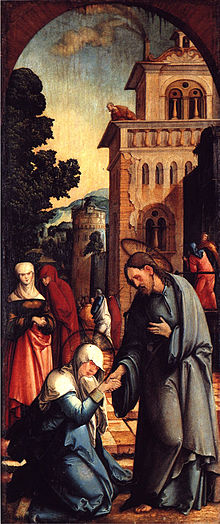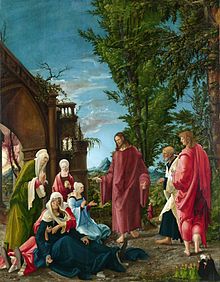
Albrecht Dürer, sometimes spelled in English as Durer, was a German painter, printmaker, and theorist of the German Renaissance. Born in Nuremberg, Dürer established his reputation and influence across Europe in his twenties due to his high-quality woodcut prints. He was in contact with the major Italian artists of his time, including Raphael, Giovanni Bellini, and Leonardo da Vinci, and from 1512 was patronized by Emperor Maximilian I.
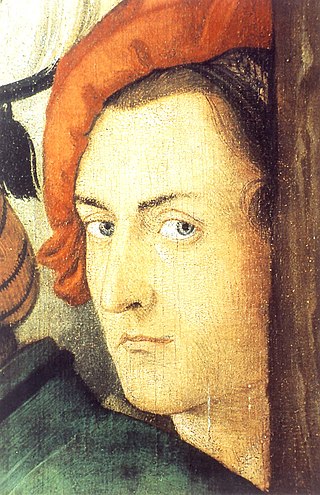
Hans Baldung, called Hans Baldung Grien,, was a painter, printer, engraver, draftsman, and stained glass artist, who was considered the most gifted student of Albrecht Dürer and whose art belongs to both German Renaissance and Mannerism.

Lucas Cranach the Elder was a German Renaissance painter and printmaker in woodcut and engraving. He was court painter to the Electors of Saxony for most of his career, and is known for his portraits, both of German princes and those of the leaders of the Protestant Reformation, whose cause he embraced with enthusiasm. He was a close friend of Martin Luther. Cranach also painted religious subjects, first in the Catholic tradition, and later trying to find new ways of conveying Lutheran religious concerns in art. He continued throughout his career to paint nude subjects drawn from mythology and religion.
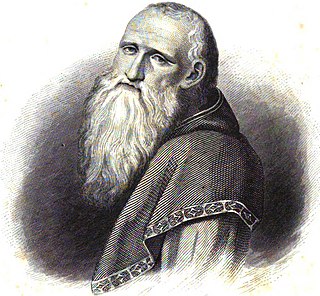
Bernardino Luini was a north Italian painter from Leonardo's circle during the High Renaissance. Both Luini and Giovanni Antonio Boltraffio were said to have worked with Leonardo directly; he was described as having taken "as much from Leonardo as his native roots enabled him to comprehend". Consequently, many of his works were attributed to Leonardo. He was known especially for his graceful female figures with elongated eyes, called Luinesque by Vladimir Nabokov.

Michael Wolgemut was a German painter and printmaker, who ran a workshop in Nuremberg. He is best known as having taught the young Albrecht Dürer.

Jan Provoost, or Jean Provost, or Jan Provost was a Belgian painter born in Mons.

The Assumption of the Virgin Mary does not appear in the New Testament, but appears in apocryphal literature of the 3rd and 4th centuries, and by 1000 was widely believed in the Western Church, though not made formal Catholic dogma until 1950. It first became a popular subject in Western Christian art in the 12th century, along with other narrative scenes from the Life of the Virgin, and the Coronation of the Virgin. These "Marian" subjects were especially promoted by the Cistercian Order and Saint Bernard of Clairvaux.

Joachim and Anne Meeting at the Golden Gate is a 1504 woodcut by the German artist Albrecht Dürer that depicts the standard scene of Joachim and Anne Meeting at the Golden Gate. In the woodcut, the parents of the Virgin Mary, Joachim, and Anne meet at the Golden Gate of Jerusalem, upon learning that she will bear a child.

The Life of the Virgin, showing narrative scenes from the life of Mary, the mother of Jesus, is a common subject for pictorial cycles in Christian art, often complementing, or forming part of, a cycle on the Life of Christ. In both cases the number of scenes shown varies greatly with the space available. Works may be in any medium: frescoed church walls and series of old master prints have many of the fullest cycles, but panel painting, stained glass, illuminated manuscripts, tapestries, stone sculptures and ivory carvings have many examples.

The Lamentation of Christ is a very common subject in Christian art from the High Middle Ages to the Baroque. After Jesus was crucified, his body was removed from the cross and his friends mourned over his body. This event has been depicted by many different artists.

The life of Christ as a narrative cycle in Christian art comprises a number of different subjects showing events from the life of Jesus on Earth. They are distinguished from the many other subjects in art showing the eternal life of Christ, such as Christ in Majesty, and also many types of portrait or devotional subjects without a narrative element.

The Apocalypse, properly Apocalypse with Pictures, is a series of fifteen woodcuts by Albrecht Dürer published in 1498 depicting various scenes from the Book of Revelation, which rapidly brought him fame across Europe. These woodcuts likely drew on theological advice, particularly from Johannes Pirckheimer, the father of Dürer's friend Willibald Pirckheimer.

The Mass of Saint Gregory is a subject in Roman Catholic art which first appears in the late Middle Ages and was still found in the Counter-Reformation. Pope Gregory I is shown saying Mass just as a vision of Christ as the Man of Sorrows has appeared on the altar in front of him, in response to the Pope's prayers for a sign to convince a doubter of the doctrine of transubstantiation.

Saint Michael Fighting the Dragon is a woodcut of 1498 by Albrecht Dürer, part of his Apocalypse series, illustrating the Book of Apocalypse or Revelation of St. John.
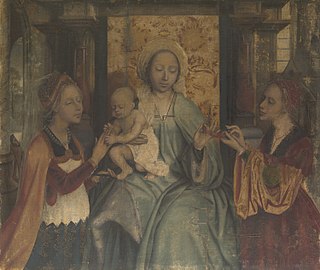
Glue-size is a painting technique in which pigment is bound (sized) to cloth with hide glue, and typically the unvarnished cloth was then fixed to the frame using the same glue. Glue-size is also known as distemper, though the term "distemper" is applied variously to different techniques. Glue-size was used because hide glue was a popular binding medium in the 15th century, particularly among artists of the Early Netherlandish period, who used it as an inexpensive alternative to oil. Although a large number of works using this medium were produced, few survive today, mainly because of the high perishability of linen cloth and the solubility of hide glue. Well-known and relatively well-preserved – though substantially damaged – the most notable examples include Quentin Matsys' Virgin and Child with Saints Barbara and Catherine and Dirk Bouts' Entombment. In German the technique is known as Tüchleinfarben, meaning "small cloth colours", or Tüchlein, derived from the German word for “handkerchief”.

The Swoon of the Virgin, in Italian Lo Spasimo della Vergine, or Fainting Virgin Mary was an idea developed in the late Middle Ages, that the Virgin Mary had fainted during the Passion of Christ, most often placed while she watched the Crucifixion of Jesus. It was based on mentions in later texts of the apocryphal Gospel of Nicodemus , which describe Mary swooning. It was popular in later medieval art and theological literature, but as it was not mentioned in the Canonical Gospels, it became controversial - Protestants rejecting it outright, and from the 16th century discouraged also by many senior Catholic churchmen.

The Holy Family with the Dragonfly, also known as The Holy Family with the Mayfly, The Holy Family with the Locust, and The Holy Family with the Butterfly is an engraving by the German artist Albrecht Dürer (1471–1528) from approximately 1495. It is quite small but full of intricate detail. A very popular image, copied by other printmakers within five years of creation, it is found in most major print room collections, including the Indianapolis Museum of Art and the UK Royal Collection.
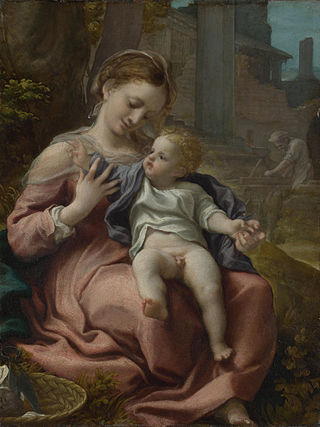
The Madonna of the Basket or the Madonna della Cesta is a painting of c. 1524 by Antonio da Correggio in the National Gallery, London. While it is a Mannerist painting of the Virgin Mary and the Baby Jesus, Correggio included naturalist touches in his composition, like the sewing basket that gives the painting its name.

The Rest on the Flight into Egypt is a subject in Christian art showing Mary, Joseph, and the infant Jesus resting during their flight into Egypt. The Holy Family is normally shown in a landscape.

Life of the Virgin is a series of nineteen woodcuts plus a frontispiece, published in book form. It was begun by Albrecht Dürer just after 1500 and only completed 1510-1511. One of the best surviving sets is now in the Staatliche Graphische Sammlung München.
